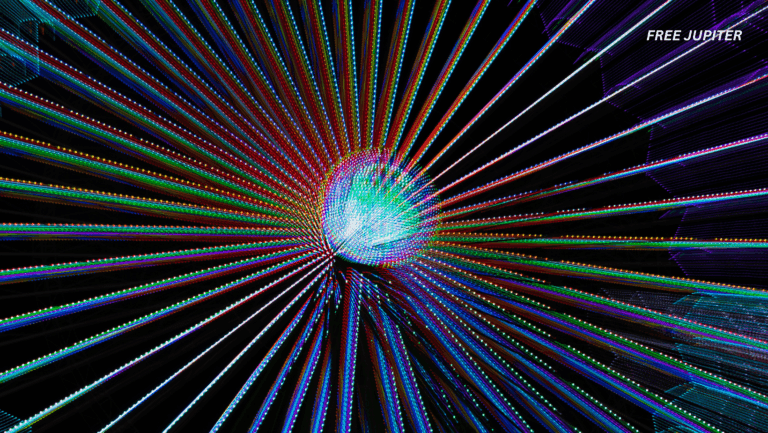Friendly Note: FreeJupiter.com shares general info for curious minds 🌟 Please fact-check all claims—and always check health matters with a professional 💙
Imagine being told that everything you see, touch, and experience—this whole vast, three-dimensional universe—is just a kind of cosmic illusion. That it might all be a clever trick of physics, like a hologram projected from a surface you can’t even see. As strange as it sounds, that’s exactly what some scientists are beginning to seriously consider. It’s a real line of thinking in modern theoretical physics, and it all starts with one of the weirdest things in the universe: black holes.
Black Holes: The Cosmic Puzzles That Changed Everything
Black holes are cosmic vacuum cleaners—regions in space where gravity is so intense that nothing, not even light, can escape. For decades, scientists assumed that once something fell into a black hole, it was gone forever. End of story.
But in the 1970s, famed physicist Stephen Hawking threw a wrench into that tidy narrative. He discovered that black holes aren’t completely black after all—they emit tiny amounts of radiation, now called Hawking radiation, and this causes them to slowly shrink and eventually disappear. The catch? That radiation doesn’t seem to carry any of the information about what fell into the black hole in the first place.
And that’s a big problem.
In physics, “information” refers to all the details that make up an object—like what it’s made of, how it’s arranged, and what it’s doing. If a black hole swallows your car, and then evaporates, there’s no trace left of the car. It’s like it never existed. But according to the laws of quantum physics, information can’t just vanish. So where did it go?
Read more: Stephen Hawking’s Final Research Paper May Have Predicted The End Of The Universe
The Black Hole’s Surface Secret: Enter Entropy
To solve this mystery, scientists turned to a concept called entropy, which is basically a measure of disorder in a system. Normally, you’d expect entropy to be related to the volume of something—how much stuff is in it. But with black holes, something weird happens: their entropy is tied to their surface area, not their volume.
This was shocking. It suggested that the black hole’s surface—the so-called “event horizon”—somehow stores all the information about what’s inside, like a kind of cosmic memory card. That’s like being told you could fit the contents of an entire building onto its front door. Totally counterintuitive.
This idea led to a bold and fascinating proposal known as the holographic principle.
The Holographic Principle: What If the Universe Is a Projection?
If black holes can store their information on a surface, maybe the entire universe does something similar. This is what the holographic principle suggests—that everything in our 3D universe may actually be “encoded” on a two-dimensional surface, like a cosmic hologram.
This isn’t just wild speculation. In 1997, physicist Juan Maldacena came up with a theory that gave the idea a serious mathematical foundation. It’s called the AdS/CFT correspondence, and while the name may sound like alphabet soup, the concept is astonishing.
Here’s the gist: Maldacena imagined a universe with five dimensions (yeah, just roll with it for a second) that curves inward and is totally empty. He discovered that solving physics problems inside this bizarre universe—especially those involving gravity—can be transformed into much simpler problems happening on the four-dimensional edge of that universe. And on that edge? No gravity at all. Just quantum physics.
So, by switching perspectives—from the “inside” of the universe to its “boundary”—Maldacena showed you could solve some of the trickiest physics puzzles, like how gravity behaves at the quantum level. This boundary version is the “hologram,” and the more complicated gravity-filled world inside is the “projection.”
Read more:Astronomers Detect The Most Powerful Explosions in the Universe Since the Big Bang
Does This Mean Spacetime Itself Is an Illusion?
Some physicists took this even further. They propose that what we think of as space and time—spacetime itself—might not be fundamental. Instead, it might emerge from the quantum interactions happening on the universe’s outer edges.
In this view, our seemingly solid, spacious, three-dimensional world might just be the end result of deep quantum activity going on elsewhere—on a two-dimensional canvas that we can’t see but from which everything springs.
It’s a bold idea. If true, it could rewrite everything we thought we knew about gravity, space, and even time itself.
Here’s the Catch: The Universe We Live In Doesn’t Match the Theory
Before we get carried away and start calling reality a hoax, let’s pump the brakes. The version of the universe used in these holographic models isn’t quite like ours. The AdS/CFT theory uses a universe with five spatial dimensions that curves inward. Our real universe has three spatial dimensions, a temporal (time) dimension, and is expanding outward, not curling in. It’s also filled with matter and energy, not empty.
Plus, our universe doesn’t appear to have a tidy outer boundary or edge where you could neatly place all the holographic information. So even if the math is beautiful and helpful, it might not apply directly to our own cosmos.
A Tool or a Truth?
This raises a deeper question: Is the holographic principle a truth about our universe, or just a very clever mathematical tool?
Physicists often use abstract or seemingly fictional mathematical frameworks to crack tough problems. Sometimes, they move systems into imaginary dimensions, flip them in time, or stretch and squash them in ways that don’t physically exist—just to make the math more manageable. It doesn’t mean they believe those altered versions are real.
However, some mathematical ideas do eventually become accepted parts of how we understand the world. Einstein’s theory of general relativity, for example, replaced our old idea of gravity as a mysterious pulling force with a new vision of curved spacetime. That shift wasn’t just mathematical—it changed how we think about the universe.
Could the holographic principle do the same? Maybe. But we’re not there yet.
So, Are We Living in a Hologram?
The jury’s still out. Some physicists think our reality is indeed an illusion—that what we perceive as space, time, and gravity are just emergent properties of something happening on a lower-dimensional surface. In that case, our universe really would be a hologram.
Others argue that the holographic principle, while useful, doesn’t describe reality itself. It’s just one of many mathematical approaches we use to understand the strange and mysterious behavior of the universe.
And that’s the beauty of science: it’s full of dazzling ideas, some of which change everything, and others that help us understand things better without turning our world upside down.
Final Thought: What If?
What if this holographic theory, weird as it sounds, is the key to unlocking the mysteries of gravity, black holes, and maybe even time itself? Or what if it’s simply a stepping stone—a brilliant trick that gets us closer to the truth without being the truth itself?
Either way, we’re still learning. After all, it took scientists over a hundred years to agree that atoms existed. And now we’re talking about the universe as a projection. Maybe, just maybe, the real magic of physics lies not in the answers, but in the questions we dare to ask.










